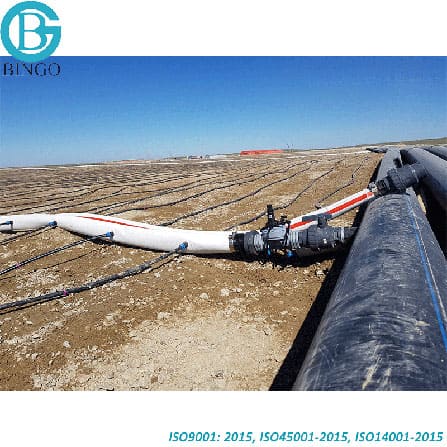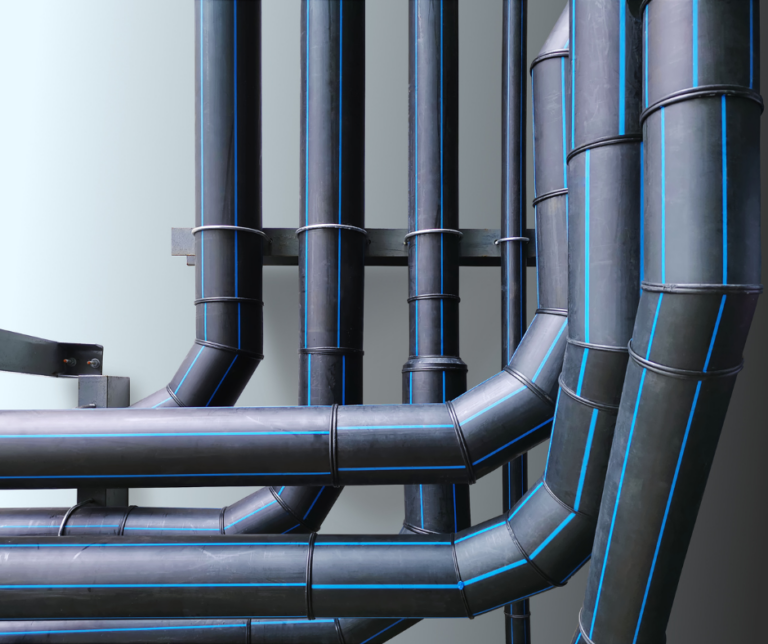Top 10 Reasons to Choose hdpe pipe suppliers Midland TX for Industrial Applications
Discover the Production Refine Behind High-Quality HDPE Pipeline and Its Applications
The manufacturing process of high-quality HDPE pipelines is intricate and methodical. It begins with the option of basic materials that boost efficiency. Following this, ethylene undergoes polymerization to create material, which is after that formed through extrusion. Quality assurance is paramount, making certain that the last item fulfills stringent requirements. Nevertheless, the trip of HDPE pipelines doesn't end with production. Their applications across numerous sectors disclose a wider importance worth taking a look at.
Comprehending HDPE: Characteristics and Advantages

High-density polyethylene (HDPE) is a versatile polycarbonate known for its resilience and resistance to numerous environmental aspects. This material shows superb tensile stamina, making it appropriate for requiring applications. Its low-density structure adds to a lightweight item, promoting convenience of handling and setup. HDPE likewise showcases impressive resistance to chemicals, which reduces deterioration when exposed to extreme substances.
The product's low dampness absorption better enhances its longevity, making it excellent for usage in pipes and tank. In addition, HDPE is resistant to ultraviolet (UV) radiation, ensuring that products preserve their stability also when revealed to sunlight. In addition, its flexibility permits for the creation of elaborate shapes without endangering strength. The environmentally friendly nature of HDPE, commonly acquired from recycled materials, contributes to its appeal, advertising sustainable practices in manufacturing. Overall, these residential or commercial properties and benefits make HDPE a recommended choice for different industrial and consumer applications.
Resources Selection for HDPE Manufacturing
The selection of raw materials for HDPE manufacturing is necessary to verify the end product satisfies the wanted specs and quality requirements. High-density polyethylene (HDPE) is largely created from polymerized ethylene, stemmed from fossil gas such as natural gas or unrefined oil. The quality of these feedstocks greatly affects the mechanical and thermal residential or commercial properties of the final HDPE.
Additives likewise play a substantial function in boosting HDPE's performance, including anti-oxidants, UV stabilizers, and colorants, which boost longevity and resistance to ecological variables. The option procedure should consider not just the chemical structure of the raw products yet additionally their handling characteristics to assure reliable production.
The sourcing of raw materials should prioritize sustainability and compliance with environmental guidelines, as accountable methods are essential in today's market. Eventually, mindful resources selection lays the foundation for producing premium HDPE pipelines appropriate for varied applications.
The Extrusion Refine: Shaping HDPE Pipe
The extrusion process plays an important role fit HDPE pipes, beginning with thorough product prep work techniques that assure suitable flow and consistency. Just as vital is the layout of the die, which directly affects the final measurements and surface top quality of the pipeline. With each other, these factors contribute significantly to the efficiency and quality of HDPE pipeline production.
Material Preparation Methods
Reliable production of HDPE pipes starts with precise material preparation methods, especially the extrusion process. Throughout this stage, high-density polyethylene resin is first dried out to get rid of dampness, making sure perfect flow attributes. The resin is after that fed into the extruder, where it undergoes home heating and melting, transforming into a thick state. This heating process is very carefully managed to maintain the material's stability and efficiency. The liquified HDPE is compelled with a die, shaping it into a continuous pipe kind. Appropriate temperature monitoring throughout extrusion is necessary, as it straight impacts the material's residential or commercial properties and the end product top quality. Once shaped, the HDPE pipeline is cooled and cut to defined sizes, all set for subsequent processing and applications.
Die Design Relevance
Accuracy in die style plays a crucial function in the extrusion process of HDPE pipes. The die functions as the final shaping device, straight influencing the pipe's dimensions, wall surface density, and surface coating. A properly designed die warranties uniform material circulation, reducing problems such as irregularities and weak points. The geometry of the die need to be optimized to suit the specific homes of HDPE, including its viscosity and thermal habits during extrusion. Additionally, the cooling rate of the product as it travels through the die can markedly influence the pipeline's architectural stability. Spending in advanced die innovation is essential for producers intending to create premium HDPE pipes that fulfill sector requirements and client assumptions.
Quality Assurance Steps in HDPE Production
Various aspects influence the high quality of HDPE pipe production, reliable top quality control measures are crucial to ensure uniformity and dependability in the last item (American Plastics HDPE Pipe for Oilfield). Key quality assurance practices consist of rigorous material assessment, validating that the raw polyethylene meets well-known galvanised handrail fittings criteria for pureness and thickness. Throughout the extrusion process, specifications such as temperature, stress, and cooling time are closely kept an eye on to keep dimensional accuracy and structural honesty
On top of that, post-production testing is necessary; producers frequently perform hydrostatic examinations to examine the pipe's stamina and resistance to pressure. Aesthetic evaluations for surface area problems additionally improve quality control. Certification from relevant requirements organizations, like ASTM or ISO, supplies an added layer of trustworthiness. By executing these complete quality control procedures, makers can reduce flaws, boost performance, and make certain that the HDPE pipes satisfy the specific requirements of various applications, ultimately leading to client complete satisfaction and rely on the item.
Applications of HDPE Pipe Throughout Industries
HDPE pipelines are made use of throughout various industries as a result of their sturdiness and convenience. In water distribution systems, they ensure efficient shipment, while in wastewater management, they supply trusted remedies for waste transportation. Furthermore, farming watering networks profit from HDPE's resistance to deterioration and adaptability, making it a suitable option for contemporary farming methods.

Water Distribution Solutions
A substantial variety of industries rely upon high-density polyethylene (HDPE) pipes for efficient water circulation systems. Recognized for their toughness and resistance to rust, HDPE pipelines are extensively made use of in metropolitan water networks, farming watering, and industrial applications. Their light-weight nature promotes simple handling and setup, reducing labor expenses and time. Additionally, HDPE pipes can accommodate different stress levels, making them suitable for both reduced and high-pressure systems. American Plastics HDPE Pipe for Oilfield. The versatility of the material enables seamless combination into existing framework, lessening the need for comprehensive excavation. HDPE's resistance to chemical seeping guarantees that the water provided stays secure and tidy, making it an optimal choice for keeping the top quality of safe and clean water across numerous markets.
Wastewater Management Solutions
Effective water distribution systems additionally lead the way for cutting-edge wastewater management solutions, where high-density polyethylene (HDPE) pipelines play a considerable duty. Distinguished for their sturdiness and resistance to rust, HDPE pipelines are ideal for carrying wastewater in numerous settings. Their flexibility enables for very easy installation in complicated atmospheres, lessening the demand for considerable excavation. Additionally, HDPE's smooth indoor surface decreases friction, enhancing circulation prices and performance. These pipes are likewise immune to chemical leaching, ensuring that pollutants do not endanger the surrounding setting. Industries, districts, and treatment centers significantly count on HDPE pipes for their reliability and durability, making them a recommended option for modern-day wastewater administration systems. This adaptability highlights the critical relevance of HDPE pipelines across various applications.
Agricultural Watering Networks
Agricultural irrigation networks benefit considerably from using high-density polyethylene (HDPE) pipelines, which give efficient and reputable water distribution to plants. HDPE pipelines are lightweight, making them simple to move and install, while their versatility enables for different configurations in diverse surfaces. These pipelines show exceptional resistance to deterioration, chemicals, and UV radiation, ensuring toughness in severe agricultural atmospheres. Furthermore, their smooth indoor surface lessens rubbing loss, maximizing water flow and decreasing energy prices related to pumping. The long life of HDPE pipes, frequently exceeding 50 years, adds to decrease upkeep and replacement costs. Subsequently, farmers increasingly depend on HDPE pipes to improve irrigation effectiveness and promote lasting agricultural practices, eventually bring about improved plant yields and resource preservation.
Future Trends in HDPE Pipeline Technology
As the need for lasting and reliable framework grows, developments in HDPE pipe innovation are poised to transform different sectors. Emerging fads include the combination of wise innovations, such as sensors and IoT capacities, which facilitate real-time blocked sewer drain surveillance of pipeline problems, lowering maintenance prices and preventing leakages. Additionally, the development of sophisticated production techniques, such as 3D printing, is making it possible for the manufacturing of complicated, customized pipeline styles that accommodate specific project demands.
Moreover, the focus on recycling and circular economy techniques is driving the technology of HDPE pipelines made from recycled materials, improving sustainability. Enhanced jointing methods, such as electro-fusion and mechanical installations, are additionally boosting setup effectiveness and reliability. The growing emphasis on environmental laws is pressing producers to embrace greener production procedures, making sure that HDPE pipes not only satisfy industry standards but also promote an even more lasting future for infrastructure advancement.
Often Asked Questions
Exactly How Does HDPE Contrast to Various Other Plastic Materials?
HDPE outshines lots of various other plastic products pertaining to longevity, chemical resistance, and flexibility. Its low thickness and high tensile stamina make it perfect for different applications, usually surpassing alternatives in both efficiency and durability.
What Are the Ecological Influences of HDPE Production?
The environmental effects of HDPE manufacturing include greenhouse gas emissions, energy intake, and possible contamination from producing processes. Additionally, improper disposal can result in dirt and water contamination, increasing issues concerning long-term environmental effects.
Can HDPE Pipeline Be Reused?
Yes, HDPE pipelines can be reused. Lots of centers accept used HDPE for handling, transforming it right into brand-new items. This reusing contributes to sustainability efforts, lowering plastic waste while saving sources and power in the production cycle.
What Is the Life Expectancy of HDPE Pipeline?

Exactly How Do Temperature Variants Influence HDPE Pipeline Efficiency?
Temperature level variants considerably impact HDPE pipeline efficiency, influencing adaptability and toughness. Heats can result in softening, while low temperature levels might trigger brittleness, eventually affecting the pipeline's longevity and suitability for different applications in diverse settings.